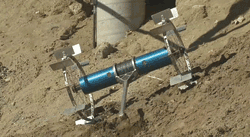A team of engineers, led by Issa A.D. Nesnas from NASA’s Jet Propulsion Laboratory, in collaboration with Professor Joel Burdick and students at the California Institute of Technology, has designed and tested a low-mass prototype rover able to navigate steep inclines and rocky terrain. Named Axel, the two-wheeled cylindrical shaped robot is the basic component in the Axel Rover System — a family of configurations designed to provide versatile mobility for exploration of planetary surfaces.

NASA’s prototype Axel rover is able to navigate uneven terrain. (Image courtesy of NASA/JPL-Caltech)
“Axel extends our ability to explore terrains that we haven’t been able to explore in the past, such as deep craters with vertically sloped promontories,” says Issa A.D. Nesnas.
Using only three actuators, the rover is capable of following arbitrary paths, turning-in-place, and can operate upside down as well as control a trailing link, which has a reaction lever arm against wheel thrust, providing redundancy in case of actuator failure, as well as adjusting the robot’s two stereo cameras. It also has a tether allowing it to be unreeled from a larger vessel or anchor point. The Axel is designed with co-location of its sensors, actuators, electronics, power, and payload inside the central cylinder, making it compact and robust against environmental extremes. For more information, visit www-robotics.jpl.nasa.gov/systems/system.cfm?System=16 or robotics.caltech.edu/~pablo/axel/home.html.
Christina D’Airo
Advertisement
Learn more about Electronic Products Magazine





